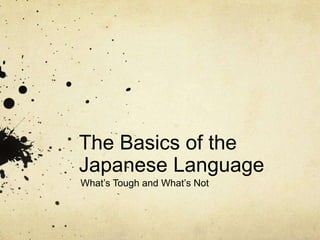
Nonline japan
- 1. The Basics of the Japanese Language What’s Tough and What’s Not
- 2. Which Would You Like to Learn…
- 3. Sounds and Word Structure Compared to English, the number of vowels used in any given word is usually higher This means that Japanese is an “open” language, or that it has an “open-syllable pattern” Most syllables end in a vowel, meaning that the pattern of most words is an alternation between a consonant and vowel
- 4. The basic vowels are /a/, /i/, /u/, /e/, and /o/. These are pronounced a bit differently than in English, /ah/, /ee/, /ooh/, /eh/, and /oh/. The basic consonants are /k/, /s/, /t/, /n/, /h/, /m/, /y/, /r/, and /w/. There is also an /N/ that stands alone from vowels and has a nasal sound. The combinations of these consonants and vowels provide all sounds needed to speak the language.
- 5. Quiz Time! What kind of syllable pattern does Japanese follow? What are the basic vowels, and how do they sound? What are the basic consonants, and which does not pair with a vowel?
- 6. Grammar and Word Order Languages are normally classified by the order of their parts, namely the subject, verb, and Object of a sentence. While English’s structure is S-V-O, a subject does a verb to an object, Japanese follows the order of S-O-V. While direct translation isn’t the clearest, this means that in Japanese a subject does to an object a verb. That’s how the sentence is formed.
- 7. Particles Particles are the pieces of grammar that show the relationships between subjects objects and verbs. For example, the particle /ha/ clearly shows what the subject of a sentence is. The particle /wo/ shows what the direct object is. For example, “John /ha/ gohan /wo/ tabeta.” John ate rice. (Gohan is rice, tabeta is “ate”)
- 8. Quiz Time! What is the basic order of a typical Japanese sentence? How does this differ from English? What is the name for a part of a sentence that denotes the relationship between subjects, objects, and verbs? Which were the two discussed earlier, and what do they show us? (Subject, object, or verb?)
- 9. Writing in Japanese The Japanese Language is split into two syllaberic “alphabets” known as Hiragana and Katakana, along with borrowed Chinese characters known as Kanji that represent words. Kanji often gives the idea of a particular meaning, while Kana offer us a specific sound. This gives each type of writing distinct advantages, which is why both are used.
- 10. Kanji were brought to Japan about 1,500 years ago from China. Before this time, Japanese was strictly a written language 500 years later, the kana were made from particular pieces of different Kanji. Kana let us sound out a word, while Kanji give learners clues as to the meaning of a word, as long as they know the Kanji of course. While Hiragana denote the sound of Japanese words, Katakana is used to borrow words from other languages, such as コンピュータ、or “konpyuuta.” Computer in English.
- 11. Quiz Time! What are the two syllaberic alphabets called in Japanese? What do they represent? What is the system of more complex symbols called, where did it come from, and when? What are the benefits to both styles of writing? Are they used together?
- 12. Moving Forward The key to learning any language is to get the fundamentals of speaking, reading, and grammar down. Using what we have learned as a basis, we can move forward on each of those fronts. The Japanese language is one rooted in history and steeped in culture. Remember, it takes time to learn a different way of speaking.
- 13. 日本語のすごい世界へようこ そ! Welcome to the wonderful world of Japanese!
